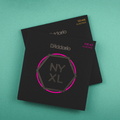The Great Acoustic Alloy Experiment
By Strings Direct – 29 August, 2023
 I was recently given the chance to buy one of my Dad’s acoustic guitars before he put it up for sale on eBay (he has far too many!). I’m not an out and out acoustic player and if I was to reach for a guitar, it’ll most likely always be an electric. However, this Sigma acoustic I acquired (OMTC-1STE-SB+... that’s a mouthful of a model number - the guitar was easier to play than the model number was to say!) turned out to be a bit of a steal of a deal so I was happy to take it off of his hands.
When I tried out the guitar, at the time I was lucky enough to have my old acoustic at hand. Having the advantage of A/B’ing them together, I was able to hear the differences there and then. Both guitars had solid Tops but the Sigma had a bigger body shape and straight away I could hear the bigger sound; it felt more open, brighter and made my old Tanglewood TW73 Sundance (Parlour Shaped) sound a bit ‘boxy’. Needless to say I bit my dad’s hand off. Since then I have sold my old acoustic on. I’d had it nearly 10 years and I loved it… it looked and sounded great but I think it was time for a change. That being said, the days you see an old guitar go are always a bit bitter sweet for me. Granted, I didn’t play it as often as I should have, but selling an old guitar for a new one always feels like you’re cheating on a girlfriend. Ah sod it, no time for reminiscing… let’s crack on with the nitty gritty… .
I thought I’d treat the Sigma to a moving-in present with some new strings. Working in a strings shop certainly has its perks, one of them being the privileged access to more sets than you can shake a Chapman Stick at. However, too much choice can sometimes be a bit overwhelming and you just end up opting for the same old set you’ve always used. I’m no different and by my own admission, I’m a creature of habit - Phosphor Bronze 10’s all day, every day! But NO! Not this time. It was time to get out of my comfort zone and, just that I did.
With this in mind, I thought I’d explore the various types of acoustic strings and see how they played and sounded on this new guitar. I think we all have that streak of guitar nerd inside us on some level, so I rolled back the years, donned my proverbial lab coat and goggles and harked back to my GCSE science class experiments (O-Level for the more mature amongst us!). When conducting an experiment, I (kind of!) remember it being important to keep certain elements constant whilst changing one variable so you can make a more informed judgment on things. The thing I wanted to explore the most was the different types of alloy in the wrap material, so the consistency in this test was going to come in the form of gauge, and brand.
I know I’m pretty happy with my choice of gauge (10-47/10-50) - bloody love a light string! [See our previous blog on ‘I like light strings and I cannot lie’ to read about my penchant for light gauge strings.]
In the past, I’d usually reach for a set of Elixir or D’Addario strings but wanted a real change so opted for some Ernie Ball strings for my little experiment. Although famous for their electric Slinkys, Ernie Ball actually produce a diverse range of acoustic strings I could play about with. They make the standard acoustic sets that most manufacturers produce, but they also make sets unique to themselves….Paradigm, Aluminum Bronze (Aluminium), Titanium Coated etc... Plus all these sets come in a variety of gauges including my trusty gauge of 10-50 so Ernie’s seemed like a good choice.
It goes without saying, the same set of strings strung on two different guitars will sound different to each other. Likewise, two different sets of strings strung on the same guitar (obviously not at the same time) will both sound different too.
Now on with the test. Over a 2-3 week period I strung the guitar up with a total of 7 different sets. In the past I’ve often found it difficult to recall exactly how I remember a string sounding from one week to the next, so with this in mind I decided to record each set on my Boss BR-80 so that I can play them back and hear them side by side. It wasn’t anything technical and just made use of the field recorder setting and made use of the built in condenser mics to try and capture as much of the natural sound of the strings as possible.
Here’s how they went down:
I was recently given the chance to buy one of my Dad’s acoustic guitars before he put it up for sale on eBay (he has far too many!). I’m not an out and out acoustic player and if I was to reach for a guitar, it’ll most likely always be an electric. However, this Sigma acoustic I acquired (OMTC-1STE-SB+... that’s a mouthful of a model number - the guitar was easier to play than the model number was to say!) turned out to be a bit of a steal of a deal so I was happy to take it off of his hands.
When I tried out the guitar, at the time I was lucky enough to have my old acoustic at hand. Having the advantage of A/B’ing them together, I was able to hear the differences there and then. Both guitars had solid Tops but the Sigma had a bigger body shape and straight away I could hear the bigger sound; it felt more open, brighter and made my old Tanglewood TW73 Sundance (Parlour Shaped) sound a bit ‘boxy’. Needless to say I bit my dad’s hand off. Since then I have sold my old acoustic on. I’d had it nearly 10 years and I loved it… it looked and sounded great but I think it was time for a change. That being said, the days you see an old guitar go are always a bit bitter sweet for me. Granted, I didn’t play it as often as I should have, but selling an old guitar for a new one always feels like you’re cheating on a girlfriend. Ah sod it, no time for reminiscing… let’s crack on with the nitty gritty… .
I thought I’d treat the Sigma to a moving-in present with some new strings. Working in a strings shop certainly has its perks, one of them being the privileged access to more sets than you can shake a Chapman Stick at. However, too much choice can sometimes be a bit overwhelming and you just end up opting for the same old set you’ve always used. I’m no different and by my own admission, I’m a creature of habit - Phosphor Bronze 10’s all day, every day! But NO! Not this time. It was time to get out of my comfort zone and, just that I did.
With this in mind, I thought I’d explore the various types of acoustic strings and see how they played and sounded on this new guitar. I think we all have that streak of guitar nerd inside us on some level, so I rolled back the years, donned my proverbial lab coat and goggles and harked back to my GCSE science class experiments (O-Level for the more mature amongst us!). When conducting an experiment, I (kind of!) remember it being important to keep certain elements constant whilst changing one variable so you can make a more informed judgment on things. The thing I wanted to explore the most was the different types of alloy in the wrap material, so the consistency in this test was going to come in the form of gauge, and brand.
I know I’m pretty happy with my choice of gauge (10-47/10-50) - bloody love a light string! [See our previous blog on ‘I like light strings and I cannot lie’ to read about my penchant for light gauge strings.]
In the past, I’d usually reach for a set of Elixir or D’Addario strings but wanted a real change so opted for some Ernie Ball strings for my little experiment. Although famous for their electric Slinkys, Ernie Ball actually produce a diverse range of acoustic strings I could play about with. They make the standard acoustic sets that most manufacturers produce, but they also make sets unique to themselves….Paradigm, Aluminum Bronze (Aluminium), Titanium Coated etc... Plus all these sets come in a variety of gauges including my trusty gauge of 10-50 so Ernie’s seemed like a good choice.
It goes without saying, the same set of strings strung on two different guitars will sound different to each other. Likewise, two different sets of strings strung on the same guitar (obviously not at the same time) will both sound different too.
Now on with the test. Over a 2-3 week period I strung the guitar up with a total of 7 different sets. In the past I’ve often found it difficult to recall exactly how I remember a string sounding from one week to the next, so with this in mind I decided to record each set on my Boss BR-80 so that I can play them back and hear them side by side. It wasn’t anything technical and just made use of the field recorder setting and made use of the built in condenser mics to try and capture as much of the natural sound of the strings as possible.
Here’s how they went down:
Paradigm 80/20 Bronze
 For a long time I’d walked past the Ernie Ball Paradigm sets in our warehouse and thought to myself “I must get round to trying them!” There’s been a lot of talk around the electric sets, but not so much on the Acoustics, so I thought ‘why not give them a bash?’ (literally, that’s what they’re made for right!?).
The acoustic Paradigms come in 2 alloy variations but I opted for the 80/20 Bronze set. I’ve always been a Phosphor Bronze man, but hey new guitar, new me right!?
First thing I noticed was the sexy inner foil packaging. Top prizes to Ernie Ball for this, they look very cool. Anyway, I digress… onto the strings. I also noted was the colour of the 80/20 Bronze sets themselves. They have a bright, almost whitey-yellow colour to them. The Paradigm set also comes with Ernie Ball’s RPS plain steel single strings. These are slightly different to normal plain steel strings as they have an additional brass winding that goes over the lock twist of the string near the ball end (see image below). This brass winding helps give stability to the string at its ball end helping to prevent the strings from breaking prematurely or from slipping.
For a long time I’d walked past the Ernie Ball Paradigm sets in our warehouse and thought to myself “I must get round to trying them!” There’s been a lot of talk around the electric sets, but not so much on the Acoustics, so I thought ‘why not give them a bash?’ (literally, that’s what they’re made for right!?).
The acoustic Paradigms come in 2 alloy variations but I opted for the 80/20 Bronze set. I’ve always been a Phosphor Bronze man, but hey new guitar, new me right!?
First thing I noticed was the sexy inner foil packaging. Top prizes to Ernie Ball for this, they look very cool. Anyway, I digress… onto the strings. I also noted was the colour of the 80/20 Bronze sets themselves. They have a bright, almost whitey-yellow colour to them. The Paradigm set also comes with Ernie Ball’s RPS plain steel single strings. These are slightly different to normal plain steel strings as they have an additional brass winding that goes over the lock twist of the string near the ball end (see image below). This brass winding helps give stability to the string at its ball end helping to prevent the strings from breaking prematurely or from slipping.
 I must admit I did have a preconception of what these might sound like. 80/20 bronze strings are renowned for being brighter in tone than their phosphor bronze counterparts so I thought they may sound a bit tinny. Alas I was mistaken and my first impressions were very positive. Although they were bright, they weren’t harsh and were very well balanced. Even with a pick (.46mm Jim Dunlop Nylon) the brightness was accentuated but not to the point where they became overly trebley. I thought the strings projected well and whilst I was just playing on my own, I can imagine in a band situation they’d cut through the mix nicely if you found yourself trying to compete with other instruments. Over a couple of days, they held their tuning pretty well too. I’m not an aggressive player so can’t say I put the Paradigms fully through their paces but on the whole it was a good start. They also sounded great on the recording with a nice full and punchy tone to them, even though I was using an ‘extra light’ gauge.
I must admit I did have a preconception of what these might sound like. 80/20 bronze strings are renowned for being brighter in tone than their phosphor bronze counterparts so I thought they may sound a bit tinny. Alas I was mistaken and my first impressions were very positive. Although they were bright, they weren’t harsh and were very well balanced. Even with a pick (.46mm Jim Dunlop Nylon) the brightness was accentuated but not to the point where they became overly trebley. I thought the strings projected well and whilst I was just playing on my own, I can imagine in a band situation they’d cut through the mix nicely if you found yourself trying to compete with other instruments. Over a couple of days, they held their tuning pretty well too. I’m not an aggressive player so can’t say I put the Paradigms fully through their paces but on the whole it was a good start. They also sounded great on the recording with a nice full and punchy tone to them, even though I was using an ‘extra light’ gauge.
[ NERDSVILLE ]
Let me just ramp up a bit of the nerdyness here if I may. The term ‘80/20 Bronze’ refers to the percentage ratio of Copper to Zinc in the outer wrap wire of the wound strings (80% Copper to 20% Zinc). Technically this ratio of copper to zinc is also known as brass. What!? Yeah I know, confused? You will be! Bronze is technically an alloy of copper and tin not copper and zinc. Therefore the ‘80/20 Bronze’ name is a little misleading but, for the purposes of conforming to the guitar string world’s way of looking at things, we’ll accept the name for what it is. Nothing’s ever easy is it!?
Phosphor Bronze on the other hand is a good boy and it’s name is a little more technically accurate. Phosphor Bronze’s ratio is 92/8 (92% copper to 8% tin with a little sprinkle of phosphorus in there for good measure).
Earthwood Phosphor Bronze
 Next up for testing was the Earthwood Phosphor Bronze set. The first thing I visually noticed was the different colouring of the wound strings against the 80/20 set I had just removed. These were more ‘bronze’ coloured than the bright, gold finish of the 80/20 bronze set (sounds stupid to say I know but if you were to hold the two sets side by side you can certainly see the difference). IMAGE
Sound wise, the first thing I noticed was that they certainly weren’t as bright as the Paradigm 80/20 bronze set. They weren’t dull by any stretch of the imagination, however, just didn’t appear to project as much and give as much volume on this particular guitar.
They noticeably had less ’zing’ than the Paradigm set which I had liked. I must admit, I don’t think I was as keen on these as the previous set, however, they were nice and comfortable to play and grew on me the more I played them. After listening back to these strings, I actually think they sounded great and better than I had initially thought.
Next up for testing was the Earthwood Phosphor Bronze set. The first thing I visually noticed was the different colouring of the wound strings against the 80/20 set I had just removed. These were more ‘bronze’ coloured than the bright, gold finish of the 80/20 bronze set (sounds stupid to say I know but if you were to hold the two sets side by side you can certainly see the difference). IMAGE
Sound wise, the first thing I noticed was that they certainly weren’t as bright as the Paradigm 80/20 bronze set. They weren’t dull by any stretch of the imagination, however, just didn’t appear to project as much and give as much volume on this particular guitar.
They noticeably had less ’zing’ than the Paradigm set which I had liked. I must admit, I don’t think I was as keen on these as the previous set, however, they were nice and comfortable to play and grew on me the more I played them. After listening back to these strings, I actually think they sounded great and better than I had initially thought.
Earthwood 80/20 Bronze Silk and Steel set
The concept of a silk and steel string was always something that intrigued me. Rather than being manufactured in the traditional way with the outer wrap material being wound directly over a central core, ‘Silk and Steels’ have a thin layer of silk sandwiched between these two components, which you can see in the image below. The purpose of this being that it ‘softens’ the strings’ tone and is meant to make the strings a bit easier to play.
Straight out of the pack, I noticed that we were back to the familier yellowy colour of the 80/20 bronze wrap wire and these indeed did appear to have a bit more flexibility in the wound strings just by holding them in my hands. When stringing them up I was thinking to myself “I’m not too sure about these.” I had a preconceived idea that they were going to be like classical strings (due to the silk underneath the winding) and be too mellow and just not to my taste. They certainly didn’t sound as bright as either the 80/20 Bronze or Phosphor Bronze sets which again I wasn’t as keen on to begin with. However, after a while I got out of the headspace of continually making a comparison to the other sets and instead just accepted that these were meant to sound different for a reason.. Yes they didn’t have the brightness, but they sounded great when playing with a bit more aggression which allowed you to attack the strings without getting harsh overtones that could be associated with some of the other ‘brighter’ sets. There certainly was a little less tension in these too, which made them very comfortable to play so they may suit players that struggle with RSI or have arthritis issues. They’d certainly mellow out a bright sounding acoustic, which they did in this instance and I certainly wouldn’t rule out opting for a set of Silk and Steel’s in the future. Listening back to the recording of this set, they were certainly more mellow than the previous sets and the top strings appeared to stand out a little more against the bass strings. Although this set sounded different to the other two, it wasn’t a bad thing. They offered something different and still sounded pretty damn good to my ear.
Earthwood 80/20 Bronze Set
I’d previously tested the Paradigm set and Silk and Steel’s which whilst both were different, they are both wound with 80/20 Bronze wrap wire. This particular set is the more conventionally ‘standard’ 80/20 set in Ernie Ball’s acoustic range. Straight away I noticed that the nice bright zingyness returned and these sounded a little bit more trebly than the Paradigms as I recalled. The familiar projection and volume was still there (as I had expected it to be) and I was starting to think that this type of string really suited this particular guitar. One thing that I did like about these and that I hadn’t noticed with the previous sets was that they were nice and responsive to your playing; if you played hard they really brightened up and likewise if you had a softer touch they retained a nice warmth to them. I loved these strings. No nonsense and no bells and whistles, just a lovely bright, rounded tone that gave the guitar a ‘big’ voice.
Aluminium Bronze
The penultimate set in my test was the Aluminum Bronze set. Aluminium Bronze is a unique alloy to Ernie Ball and the wrap wire comprises a mix of copper and aluminium (as opposed to copper and tin) which Ernie Ball say gives more ‘projection and clarity than traditional (phosphor) bronze’. Throughout my test so far I’d certainly developed a penchant for the 80/20 set (especially on this particular guitar) so I was excited to see how the Aluminium Bronze sized up. Once I’d strung these up my first impressions were that these sounded nice and bright (which is what I was starting to look for)….a challenger for the 80/20 bronze’s crown perhaps? Whilst they were bright, they weren’t too trebley.. I’m not too much of a finger picker but when I did play fingerstyle they gave a nice clear crisp tone. I can imagine that if there was somebody out there who was using a set of Phosphor Bronze strings but fancied something with a tad more bite, these could be just the ticket. These were definitely up there and if somebody gave me a set of these to put on my guitar again I’d be a happy boy indeed! To my ear, the Aluminium Bronze set came across as the most ‘lively’ strings when I listened back to them. They gave the guitar a jangleyness and really seemed to accentuate the mid-upper ranges of this particular acoustic.Everlast Coated 80/20 Bronze
 The final set under the microscope was the Everlast Coated 80/20 Bronze set.
I was curious to see how the coating felt on these strings. Coated strings are always a bone of contention for most players; whilst they offer a greater lifespan, many feel any type of coating dampens and hinders their natural tone. Uniquely, Ernie Ball coat the core on their Everlast strings as well as the wrap wire which is quite unusual. The core is treated to avoid it corroding and the coating also helps repel moisture and the acidic oils in sweaty hands...the exact type of nasties that make our strings sound dead!
The final set under the microscope was the Everlast Coated 80/20 Bronze set.
I was curious to see how the coating felt on these strings. Coated strings are always a bone of contention for most players; whilst they offer a greater lifespan, many feel any type of coating dampens and hinders their natural tone. Uniquely, Ernie Ball coat the core on their Everlast strings as well as the wrap wire which is quite unusual. The core is treated to avoid it corroding and the coating also helps repel moisture and the acidic oils in sweaty hands...the exact type of nasties that make our strings sound dead!
On first playing these sets, if I hadn’t have known it, I certainly wouldn’t have said that the Everlast Strings were a coated string simply by feel. Tonal wise, they may have been ‘oh so slightly’ warmer in comparison to standard 80/20 bronze set but this was negligible. On the recording I thought these sounded great. They offered everything that I had come to like about the 80/20 bronze alloy so it was going to prove tough to choose a winner.
Conclusion
I must conclude by saying that by carrying out this experiment it was clear to see just how beneficial it is to play around with as many different types of strings as you possibly can. I enjoyed this process tremendously. In the past I was certainly guilty of always reaching for the same old set of strings I’d always used. However, testing all these strings has opened my eyes to sets that I often overlooked in the past. It’s not until you actually try them on your own guitar that you get a feel for how they interact with your style of playing and your instrument. Incidentally, if you wanted to try the Ernie Ball’s yourselves, they do offer the Aluminium Bronze, 80/20 Bronze and Phosphor Bronze in a pre packaged ‘Tone Pack’ in gauges 11-52 and 12-54. So down to business. My favourite set was…..drum roll please…...the Earthwood 80/20 Bronze set. I would never have thought this would be the case at the start, but for me they just had a bright, well rounded tone that really resonated with however I chose to play the guitar. The Paradigms came in a very close second place and in actual fact, probably came across as the best ‘sounding’ string out of all my recordings. That being said, the Earthwoods were my winner in this instance. After trying so many different sets I did come to the realisation that my preferred set here was a result of the strings coupled with the guitar itself and my playing style. I’m a fairly light player. I’m not heavy handed, so this is probably why the 80/20 bronze set were better for me. ‘For me’ being the important phrase here. It’s so easy to dismiss a set and simply say “oh I’ve heard silk and steel’s sound rubbish” But, it’s important to take into account what else is contributing to a sound you’re hearing? It’s not just the strings. Whos’ playing the guitar? What style are they playing (fingerstyle, strumming chords)? What size is the body? What’s it made from? How hard are they hitting the strings? Are they using a pick? Are they using a pickup? All these individual elements contribute to the overall tone you hear and will dictate just just how bright or how warm a set will sound. I’d certainly encourage anybody to do your own experimentation. Who knows? Your guitar’s sweet spot of tone may lie in the totally unexpected and have you shouting from the rooftops; “Silk and Steel’s are the futuuuuurrrrrreeee!!!!” Don’t knock it ‘til you’ve tried it… and I recommend trying as many as you can!




